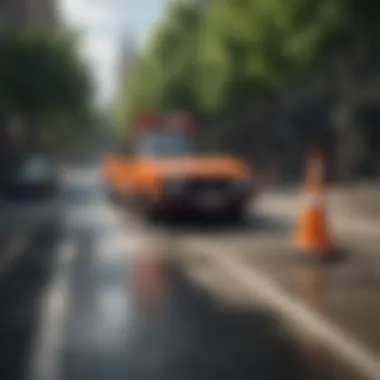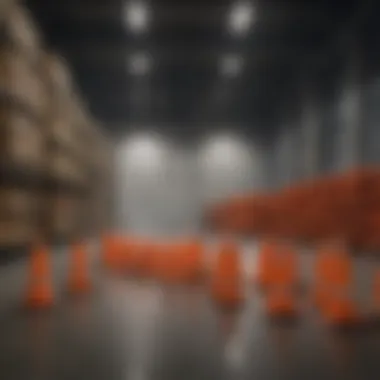Understanding Long Traffic Cones: Their Applications & Impact


Intro
Long traffic cones are often overlooked yet play crucial roles in various domains, especially in traffic management and construction settings. Their design enables clear visibility and stands resilient against the elements while guiding and delineating spaces efficiently. This article delves into the applications and specifications of long traffic cones and their broader impacts in promoting safety and organization in complex environments.
Long Traffic Cones: An Overview
Long traffic cones, typically measuring over 36 inches, serve many purposes. Their high visibility, often achieved through brightly colored materials, makes them crucial for directing traffic and indicating hazardous areas. In construction sites, they represent boundaries, protecting workers and enhancing overall safety. With adaptable designs and varied specifications, these cones can fulfill requirements from urban to rural landscapes.
Applications of Long Traffic Cones
Traffic Management
In traffic situations, particularly in urban areas, long traffic cones are essential in controlling the flow of movement and ensuring safety. They easily mark lanes or indicate roadworks, guiding drivers effectively. Furthermore, imperfections in road conditions can have serious implications. Thus, cones help users become aware of risks ahead, significantly reducing accidents.
Construction Sites
Long traffic cones are integral to managing construction zones. Their ability to delineate restricted areas allows for organized and efficient resource deployment. Workers are visually guided and, thus, less likely to misstep into dangerous zones. By establishing clear signs, cones promote an orderly environment amid bustling activity.
Event Management
Long traffic cones are used during public gatherings and events to designate areas for pedestrian traffic. They facilitate organized queuing patterns and safe movement through designated pathways. Maintaining spatial boundaries can ease transitions between crowded zones and minimize confusion or accidents.
Specifications of Long Traffic Cones
Understanding the features of long traffic cones can help professionals select the right type for various applications. Generally, these specifications include height, material, weight, and whether they provide reflective elements.
Height and Visibility
One of the most crucial specifications is the numeric height, as longer cones (usually above 36 inches) provide greater visibility over traffic conditions. The elevation confirms that, along with placement, pedestrians and drivers can quickly identify their presence.
Material Resilience
Long traffic cones are often made from flexible yet firm materials, such as PVC (Polyvinyl Chloride) or rubber. These materials enforce durability, allowing the cone to stand erect regardless of instances when struck by vehicles. Likewise, they resist harsh weather, ensuring consistent performance.
Weight Considerations
The weight of the cone proves significant as well. Heavier cones typically remain upright without falling when faced with strong winds or bump contact from vehicles while lighter versions are more portable, facilitating ease of deployment in setting busy temporary traffic channels.
Reflective Properties
Cones with reflective capabilities enhance safety at night. Some cones are complemented with reflective bands, ensuring visibility in low light and dark conditions, offering an indispensable safety feature in managing road and construction zones.
Best Practices for Usage and Maintenance
Ensuring effective deployment and longevity of long traffic cones involves adherence to specified practices. Proper positioning, periodic inspections, and awareness of surrounding conditions improve both functionality and safety across varied contexts.
Proper Placement
Identifying prime locations to place the cones ensures maximum effectiveness. They should avoid locations that hinder visibility but drawing attention to spaces meant for management during transportation or construction tasks is critical. Key access points or intersections often warrant focused attention.
Regular Inspections
Offering ongoing functional assessments can determine if maintenance is necessary. Conditions may include evaluating how cones endure changing weather elements or physical damage. Any failures to proactively replace or repair faults on cones risk safety and manageability deterioration.
Cleanliness and Storage
Maintaining cleanliness and proper storage prolongs life expectancy. Generally, cleaning these structures involve rinsing with water or solutions targeting embedded dust or grime from general use. Furthermore, potential storage areas should accommodate easy access, preventing potential injuries or abuse through environmental exposure.
Long traffic cones maintain safety and order while maximizing work and movement efficiency in various settings. Consistent practice and utilization play an essential role in their success.
Prolusion to Long Traffic Cones
Long traffic cones serve an important function in various industries, enhancing safety and organization. These tools are essential in managing traffic flow and are often employed in construction sites, events, and emergency situations. Securities in events or construction highly depend on them to ensure safe pathways and procedures. Hence, their presence is crucial in enhancing awareness of potential hazards.


Definition and Purpose
Long traffic cones are typically high, tapered markers used to delineate areas and direct traffic. Their primary purpose is to grab the attention of drivers and pedestrians to ensure awareness of hazards such as construction zones or road closures. The cones often feature reflective elements to improve visibility, especially in low-light conditions. They also serve functional purposes, marking boundaries and guiding users where to go. Common applications include roadworks, event setups, and emergency scenes, making them versatile tools in managing spatial logistics.
History and Evolution
The history of long traffic cones can be traced back to older warning devices that were less effective. Early cones were made of various materials, including wood and metal, making them less portable and visible. Over time, the design progressed with advancements in materials and technology.
The modern long traffic cone, often constructed from durable plastic, became prominent in the late 20th century. This evolution fostered better design practices targeting visibility and durability. Innovations such as stackability for ease of transportation held great importance, ensuring that they met industry demands. The evolution of long traffic cones illustrates a significance in responding to modern needs while fulfilling their original purpose effectively.
Understanding the history and evolution of long traffic cones helps industries realize their advancements, embracing better designs while fulfilling critical roles in safety and efficiency.
Design Specifications
Understanding the design specifications of long traffic cones is crucial for both functionality and safety. These specifications influence how effectively these cones serve their purpose in various environments. Each element contributes to the overall effectiveness of traffic cones, making them valuable tools in traffic management, construction, and other disciplines requiring organization and safety.
Material Composition
The materials used in the production of long traffic cones can vastly influence their performance. Typically, they are made from durable plastics like polyethylene or PVC. These materials are chosen for their ability withstand harsh weather conditions, UV radiation, and physical wear.
- Weather Resistance: The right material will ensure cone longevity by safeguarding it against rain, snow, and sun deterioration.
- Lightweight Nature: A lightweight material makes it easier to transport and manipulate, essential for situations where cones are frequently deployed.
- Flexibility and Stability: A small degree of flexibility in the material can prevent cones from being easily tipped over by wind or minor collisions, helping them maintain visibility in traffic situations.
Size and Height Variations
Long traffic cones come in various sizes and height configurations, typically ranging from 18 inches for smaller indoor setups to as tall as 36 inches for outdoor use. The size of the cone is directly optimized for its environment and intended use:
- Indoor Applications: Shorter cones can effectively manage flow and ensure safety in environments like warehouses.
- Highway Use: Taller cones are visible from greater distances, essential for alerting drivers to hazards or changes in traffic patterns.
It's necessary to choose the right height based on visibility and the surrounding context. Overly tall cones may not fit in smaller spaces, while too short can compromise visibility. These factors create a balance that enhances responsibility on the street.
Color and Visibility Features
Visibility is a paramount characteristic of long traffic cones. The color and reflective features enhance their effectiveness considerably. Most cones employ a bright orange hue to grab attention under various conditions:
- Reflective Strips: Some cones are designed with reflective bands, allowing them to be seen even at night or in adverse weather conditions. This indicates their importance for night-time construction or accident scenes.
- Color Psychology: Bright colors can incite caution in the human psyche. Bright orange or lime green colors alert the public to potential danger and lead people towards safer paths.
Using the appropriate color and visibility features is essential to maximize the effectiveness of safety equipment on-site.
Functional Applications
The functional applications of long traffic cones represent a significant aspect of their utility. Long traffic cones serve multiple roles ranging from organization to safety in diverse environments. The precise function in each context highlights their versatility and the importance of selecting the right tool for specific situations. Understanding these applications is essential for professionals working in traffic management, event organization, and construction, as it allows for better operational planning.
Traffic Management
Long traffic cones are instrumental in traffic management systems. They are commonly used to delineate lanes, guide Vehicles, and alert drivers to upcoming hazards. Their visibility, especially in low-light or bad weather, helps prevent potential accidents.
Key benefits include:
- Clear Lane Marking: Long cones provide clear boundaries, helping ensure that vehicles follow designated paths.
- Reduced Confusion: Using cones creates a visual guide which diminishes the uncertainty among drivers when navigating complex road situations.
Effective use of cones also considers placement. Deploying them at strategic points, such as construction sites or during special events, reinforces their effectiveness.
Construction Sites
In construction zones, long traffic cones play a pivotal role in directing traffic around barriers and hazards. Here, their physical presence is not only vital for traffic flow but also secures work zones.
Considerations include:
- Enhanced Safety: Utilizing long cones keeps vehicles at a safe distance from construction activities. This minimizes the risks involved for both workers and motorists.
- Organized Workflows: They facilitate smooth traffic movement around the site, allowing construction operations to progress with unprécédented efficiency.
Construction sites often require zoning and boundaries, and long traffic cones effectively signal where these boundaries are. Employing them correctly can lead to streamlined workflows and reduced liability for contractors.
Event Management


During large events, crowd control and safety are paramount. Long traffic cones assist in guiding attendees from points of entry to specific areas, ensuring smooth foot traffic flow. Their flexible uses cater to concerts, festivals, or trade shows by creating defined environments within vast spaces.
Advantages include:
- Channeling Attendees: They guide people appropriately, preventing overcrowding in specific spots.
- Safe Navigation: Clearly marked paths with long cones help avoid confusion and ensure safety within busy event environments.
Event planners must consider the specific layout and anticipated crowd traffic when placing cones. Strategic positioning leads to better crowd management and can diminish complications.
Emergency Services
Long traffic cones have a critical role in emergency service scenarios. Their visibility aids first responders in directing and controlling both pedestrian and vehicular movements during emergencies.
The importance of their use includes:
- Clear Protocols for Evacuation: Emergency responders can employ cones to establish safe routes for evacuation during crises.
- Visibility for On-Site Operations: Long traffic cones signal hazards and prevent operations from encroaching upon the emergency's locus.
Being well-versed in applying cones in emergency contexts helps responders maintain control, which is crucial for success in crisis situations.
Effective use of long traffic cones helps keep emergency operations organized, ultimately preserving lives and property.
With proper understanding and effective deployment of long traffic cones across these varied applications, professionals can enhance safety, organization, and efficiency in their respective fields. For example, integrating traffic cones systematically boosts operational protocols like those found in traffic management and emergency responses directly.
Safety Considerations
Importance of Visibility
Visibility is critical when using long traffic cones. They need to be easily seen to effectively communicate warnings and directions to drivers and pedestrians. Traffic cones in bright colors like orange or fluorescent yellow can reduce the chance of accidents in settings ranging from construction zones to traffic management. It is essential that these cones are equipped with reflective materials or tape that enhance visibility at night or in poor weather conditions.
Proper placement also plays a key role in increasing visibility. Positioning cones at the onset of potential hazards highlights risks early and gives individuals adequate response time. Lack of visibility can lead to confusion and increased risks. Therefore, enforcing strict visibility standards for the use of traffic cones can significantly influence safety activities.
Preventing Accidents
Preventing accidents with long traffic cones involves several crucial strategies. These tools serve multiple functions that contribute directly to the reduction of risks. When strategically placed, long traffic cones can define boundaries for working zones, manage traffic flows, and guide movements of vehicles and pedestrians. Each of these roles is critical in averting mishaps.
Best Practices for Usage
Understanding best practices for the usage of long traffic cones is crucial for optimizing their effectiveness and ensuring maximum safety. Proper usage not only enhances their intended functionality but alsi minimizes risks related to accidents and miscommunication in various settings.
To deploy long traffic cones effectively, it is vital to engage with a few core elements:
- Context Awareness: Knowing the environment where cones will be used is paramount. Different sites require adjusted strategies, corresponds thus to directional signalling or barrier functions. In construction zones, proximity to active machines warrants more significant placement strategies compared to pedestrian areas.
- Visibility Enhancements: Adjust hoc measures, like adding reflective tape or lights, can be greatly potent when placed at night or low-light situations. Enhancements encourage attentiveness from motorists or pedestrians thus prevent dangers.
Adhering to these practices not only promotes compliance with safety norms but alsi aids significantly in keeping treatments spatial awareness. Enhanced safety comes with effective organization, paths stay clear and predictable.
Placement Guidelines
Correct placement of long traffic cones informs the actual flow dynamics in a given area. This consideration becomes essential, especially in crowded or dynamic environments. Key factors regarding placement include:
- Spacing: Ensure cones are placed adequately spaced out to clearly mark boundaries or hazardous areas.
- Angle and Orientation: The direction in which cones are placed can be a deciding factor.
- In construction sites, staggering cones can help delineate zones for vehicles and pedestrian traffic.
- On roads, spacing conveys continuous guidance, preventing confusion.
Important Note: Traffic cones should face towards approaching traffic so they promote a clear understanding of intended traffic patterns.
Correct orientation means intentional guiding rather than an arbitrary hindrance. By positioning them with thought and deliberation, stronger resultant compliance to flow rules will often occur.
Maintenance and Storage
Taking care of long traffic cones is an essential aspect of extending their usability and maintaining safety practices. Proper maintenance practices lead to durability and assures that cones remain visible and effective. Here are some recommendations:
- Cleaning: Regular inspections and cleaning are adviisable to remove dirt and grime. Keeping cones clean ensures maximum visibility and effective functionality. Non-abrasive cleaners diluted in warm water suffice.
- Check for Damage: Conduct consistent check-ups for signs of wear and tear. Any cracks, fading, or missing bases impair the cones effectiveness.
- Storage Highlights:
- Store traffic cones in a designated area that is dry and away from harsh outdoor elements.
- Stack cones neatly with the smaller one inside the larger cone to save space and maintain ewssential structural integrity.


These guidelines stress the value of both proactive measures longe-serving cones and necessitate longer projects with sustainable practices. Well-kept cones promote ongoing safety.
Environmental Impact
The environmental impact of traffic cones, specifically long traffic cones, addresses how their production, use, and disposal influence ecological systems. As traffic management and construction become increasingly intertwined with environmental consciousness, understanding this impact is crucial for professionals in these sectors.
Factors like material sustainability and end-of-life considerations come into sharper focus as we look deeper into the environmental aspects of long traffic cones. By evaluating these components, we can develop better strategies that balance practical needs with eco-friendly approaches.
Sustainability of Materials
A primary concern when examining long traffic cones is the sustainability of materials used in their manufacturing. Most cones are made from plastics like PVC, which are durable but can pose a challenge to environmental safety if not handled properly.
Some manufacturers are turning to bio-based plastics, which are derived from renewable resources and significantly limit pathogen emissions associated with standard plastic materials. Additionally, utilizing recycled plastics can play an important role in reducing the demand for virgin materials. The life cycle assessment of these materials illustrates both environmental benefits and the potential reduction of non-renewable resource consumption.
Adopting eco-friendly materials can also enhance public reputation, reflecting a commitment to sustainability that resonates well with responsible consumers. Making the transition will require education among users, so they can advocate conscious product choices both in industry and daily usage.
Recycling and Disposal
When understanding environmental impact, the recycling and disposal methods of discarded long traffic cones come to the forefront. Many municipalities struggle with proper disposal due to the materials used. In order to mitigate landfill overflow and second-hand material waste, productive methods for managing waste must be pioneered.
- Encouraging local initiatives to recycle shapes and manage damaged cones by establishing a return program.
- Collaborating with materials reprocessors who can recycle cones into new products or other manufacturing processes.
- Sharing discussions within industry-specific forums or on platforms like Reddit to inspire innovation when focussing on sustainable practices.
One has to keep in mind the ecological footprint of getting rid of these items. Disposing of cones in landfills is the least preferred option. Instead, educating all stakeholders on proper recycling methods and the importance of circular economy principles will aid in making disposal processes more environmentally friendly over time.
"The choice of materials in construction and traffic management is our commitment to a sustainable future."
As we underline the discussions regarding the material sustainability and disposal pathways, it is evident that a shift towards more environmentally sound practices is both possible and needed. Continued innovation combined with public awareness is crucial to minimize adverse effects full circle. Assessing the environmental impacts of long traffic cones must continue to reflect an interest in practicality and sustainability.
Future Trends in Traffic Control Devices
The landscape of traffic control devices is shifting rapidly with new advancements and changing needs. Understanding these future trends in long traffic cones provides invaluable insights for professionals in the field. These developments highlight how innovations and technology shape road safety, organizational effectiveness, and user flexibility.
Innovations in Design
Innovation is central to improving the functionality and effectiveness of long traffic cones. Modern designs focus on durability and user-friendly features, making them increasingly efficient. For instance, many models are now produced with lightweight yet robust materials, enhancing portability and maneuverability without compromising sturdiness.
Furthermore, the aesthetic element cannot be ignored. Vibrant colors and reflective strips are essential details that boost visibility. New designs often incorporate adjustable heights and modular components. These allow for versatility in different contexts, from construction to events.
The development of ergonomic bases is noteworthy. These bases increase stability against strong winds and adverse weather. Integrating collapsible features leads to even more efficient storage and transportation options.
- Lightweight materials
- Reflective surfaces for heightened visibility
- Adjustable and modular structures
- Ergonomic designs for stability
Such innovations are sure to respond to demand, enabling users to facilitate clearer communication in chaotic environments.
Technological Integration
Technological advancements continue to drive improvements in long traffic cones. The integration of smart technologies offers new directions for traffic management. Traffic cones can now feature embedded sensors that monitor vehicle flow, enabling real-time data analysis. This fusion of technology facilitates informed decision-making for both road authorities and event managers.
Another compelling trend is the incorporation of IoT capabilities (Internet of Things) within traffic cones. Wireless connectivity can allow them to communicate with nearby smart devices or traffic lights. For example, a traffic cone could signal to a nearby drone about an emergent road hazard. Informational displays on cones can relay upcoming construction or events, ensuring users are well-informed.
Additionally, machine learning algorithms may soon analyze patterns of usage, helping manufacturers produce more specific designs tailored to common use cases or regional requirements. By understanding historical data, the design solutions can be more tailor-made to diverse environments.
With all these advancements, the move towards more integrated traffic control measures is clear and progressive.
The End
In this article, we have explored the extensive realm of long traffic cones, delving into their key aspects including specifications, applications, and their overall impact on safety and organization. The world of long traffic cones is indeed critical as these tools play an essential role across various sectors. This conclusion synthesizes the insights covered throughout and emphasizes the relevance of understanding these devices in both professional and everyday settings.
Recap of Key Points
To summarize the main points discussed:
- Definition and Purpose: Long traffic cones guide drivers and pedestrians, marking boundaries and indicating hazards.
- Application Across Fields: These cones are essential not only in traffic management but also in construction and event organization, preventing potential accidents in high-traffic areas.
- Design Specifications: The material composition, sizes, colors, and visibility features maximize their effectiveness in communication.
- Safety Statistics: Utilizing traffic cones reduces injury risks substantially, demonstrating their effectiveness in safeguarding public spaces.
- Best Practices: Proper placement and maintenance are vital to ensure that cones accomplish their safety and organizational goals efficiently.
- Environmental Considerations: Emphasis on the sustainability and responsible disposal of traffic cones can contribute positively to an organization's ecological impact.
Final Thoughts
By applying the best practices identified, both professionals and amateurs can enhance their use and effectiveness of these tools. As innovations continue to emerge in traffic control devices, staying informed is crucial for adapting long traffic cones to future challenges.
Ultimately, long traffic cones represent the intersection of design, safety, and functionality—a true indication of their value in our ever-evolving spaces.



